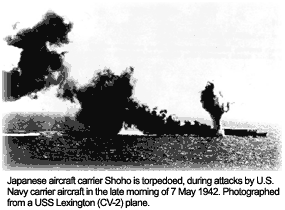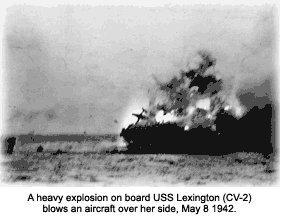From the first day of the encounter, both the Japanese and American commanders labored under inaccurate reconnaissance reports. The battle was fought in the waters of the Solomon Islands with the operations inflicting losses for both sides. American carrier aircraft, however, forced the Japanese to retire with the heaviest losses, making that battle the first-ever naval engagement in which the participating vessels did not face one another directly. The battle also resulted in a major impact on Japanese naval resources, and would later create problems for them at the Battle of Midway.
The battle unfolds
At 6 a.m. the Americans and the Japanese sent out search planes. The Americans were looking for carriers that they already knew were in the area, but the Japanese were looking for the carriers that they guessed might be present. The Japanese planes were flown off the Zuikaku in search of the enemy that they feared might approach sternward.
When the Japanese search planes spotted ships in the east at 7:30, they began to believe that the coming engagement would be an early victory. As it turned out, those ships were not the American carriers, but the American destroyer Sims, and the oiler Neosho. U.S. Rear Admiral Frank Jack Fletcher, Japanese Rear Admiral Tadaichi Hara, and Vice Admiral Takagi Takeo all wanted to stage the first attack to draw first blood. Both sides also assumed that they would emerge from the attacks victorious and sustain little damage to their own ships. Little did they know that the approaching battle would be between heavily-armed and lightly-protected aircraft carriers.
Shortly before 8 a.m., the Japanese scout planes flew over the Neosho and the Sims. The report from the pilots described them as a "carrier and a cruiser." Erroneous reports like that made the enemy think that they were approaching a much larger force than what was really in the water. At about noon, the Japanese sent out two high-level bombing attacks that, for some reason, missed both ships. The Japanese also sent out a second wave, a large force of dive bombers. Unlike the previous attack, those bombers did not miss their targets. The ships did not have any time to react and the stricken Sims was sinking fast. The crew suffered many casualties and everyone was ordered to abandon ship. The badly hit Neosho was drifting in the sea. It had lost its power and was taking on water. The crew of the Neosho radioed its position and also was ordered to abandon ship. They were barely able to get the message out before the power went off, and as they waited in the cold life rafts, they figured they would not be rescued for days.
 A few hours later, the Yorktown carrier dispatched scout planes. They came upon the Japanese Covering Group. That group consisted of the light carrier Shoho and four heavy cruisers. When the message was sent back to base, it was heard as “two carriers and four heavy cruisers.” With the thought that a huge striking force was on its way, the Yorktown and the Lexington ordered 53 scout-bombers, 22 torpedo planes, and 18 fighters to take off. That huge force managed to make their attacks worth their time. So many bombs were dropped that the Shoho sank in minutes.
The Japanese were furious with the successful attacks from the United States, and decided to attempt an assault from a different angle. They began by flying land-based torpedo planes and bombers to attack U.S. Navy cruisers stationed in Port Moresby, Australia. Those planes dropped numerous bombs as they flew over the ships, but skillful maneuvering prevented them from being damaged. After that failure, the Japanese suspended the attack at Port Moresby while they awaited the outcome of the Coral Sea battles.
On May 8, the Japanese and American carrier commanders concentrated once again on finding the enemy before the other. Just before sunrise, both sides sent out search planes, and made contact a few hours later. The Japanese misunderstood a radioed communication — being led to think that their own ships were the enemy — and had already deployed their strike planes. Soon after ascertaining the Japanese fleet's position, the U.S. carriers ordered their planes off the decks just after 9 a.m. Knowing that the battle to come would be one requiring skill and experience, task force commander Admiral Fletcher turned over operational command to Rear Admiral Aubrey W. Fitch, a veteran of the Langley, Lexington, and Saratoga.
Both Japanese and American planes came upon their respective enemies at about 11 a.m. At that time, the Japanese enjoyed the upper hand because they were partially concealed by bad weather. The Americans were not so fortunate; they steamed under clear skies. However, the American attack on the Shokaku carrier left the ship unable to launch any planes. The U.S. planes were followed later by part of the Lexington's air force. The Shokaku was so badly damaged that the ship had to be returned to the Japanese mainland for repairs. The sister ship Zuikaku lay under heavy weather nearby and was not seen by the Americans.
A few hours later, the Yorktown carrier dispatched scout planes. They came upon the Japanese Covering Group. That group consisted of the light carrier Shoho and four heavy cruisers. When the message was sent back to base, it was heard as “two carriers and four heavy cruisers.” With the thought that a huge striking force was on its way, the Yorktown and the Lexington ordered 53 scout-bombers, 22 torpedo planes, and 18 fighters to take off. That huge force managed to make their attacks worth their time. So many bombs were dropped that the Shoho sank in minutes.
The Japanese were furious with the successful attacks from the United States, and decided to attempt an assault from a different angle. They began by flying land-based torpedo planes and bombers to attack U.S. Navy cruisers stationed in Port Moresby, Australia. Those planes dropped numerous bombs as they flew over the ships, but skillful maneuvering prevented them from being damaged. After that failure, the Japanese suspended the attack at Port Moresby while they awaited the outcome of the Coral Sea battles.
On May 8, the Japanese and American carrier commanders concentrated once again on finding the enemy before the other. Just before sunrise, both sides sent out search planes, and made contact a few hours later. The Japanese misunderstood a radioed communication — being led to think that their own ships were the enemy — and had already deployed their strike planes. Soon after ascertaining the Japanese fleet's position, the U.S. carriers ordered their planes off the decks just after 9 a.m. Knowing that the battle to come would be one requiring skill and experience, task force commander Admiral Fletcher turned over operational command to Rear Admiral Aubrey W. Fitch, a veteran of the Langley, Lexington, and Saratoga.
Both Japanese and American planes came upon their respective enemies at about 11 a.m. At that time, the Japanese enjoyed the upper hand because they were partially concealed by bad weather. The Americans were not so fortunate; they steamed under clear skies. However, the American attack on the Shokaku carrier left the ship unable to launch any planes. The U.S. planes were followed later by part of the Lexington's air force. The Shokaku was so badly damaged that the ship had to be returned to the Japanese mainland for repairs. The sister ship Zuikaku lay under heavy weather nearby and was not seen by the Americans.
 The Japanese began their attack just after 11 that morning. It was a heavy swipe at the Lexington. The Japanese slammed the ship with torpedoes and tons of bombs. About an hour later, the Lexington was still afloat, having withstood the beating from the air, but fires began to appear. The crew managed to put out the fires, and the ship was declared still in service.
The battle winds down
By the end of the day, the Japanese and the Americans had pulled back from the immediate fighting area. The next day, the Japanese sent the Zuikaku back to the battle waters for a few days to ensure that the Americans would not come back to attack them, but their supplies were low, and they had to withdraw the carrier on May 11. At the same time, the Yorktown was ordered back to Pearl Harbor for some quick repairs. That vessel would soon be a decisive factor in the Battle of Midway. The Battle of the Coral Sea signaled a major development in the war because it decisively stemmed the Japanese drive to the south — and Australia.
The Japanese began their attack just after 11 that morning. It was a heavy swipe at the Lexington. The Japanese slammed the ship with torpedoes and tons of bombs. About an hour later, the Lexington was still afloat, having withstood the beating from the air, but fires began to appear. The crew managed to put out the fires, and the ship was declared still in service.
The battle winds down
By the end of the day, the Japanese and the Americans had pulled back from the immediate fighting area. The next day, the Japanese sent the Zuikaku back to the battle waters for a few days to ensure that the Americans would not come back to attack them, but their supplies were low, and they had to withdraw the carrier on May 11. At the same time, the Yorktown was ordered back to Pearl Harbor for some quick repairs. That vessel would soon be a decisive factor in the Battle of Midway. The Battle of the Coral Sea signaled a major development in the war because it decisively stemmed the Japanese drive to the south — and Australia.